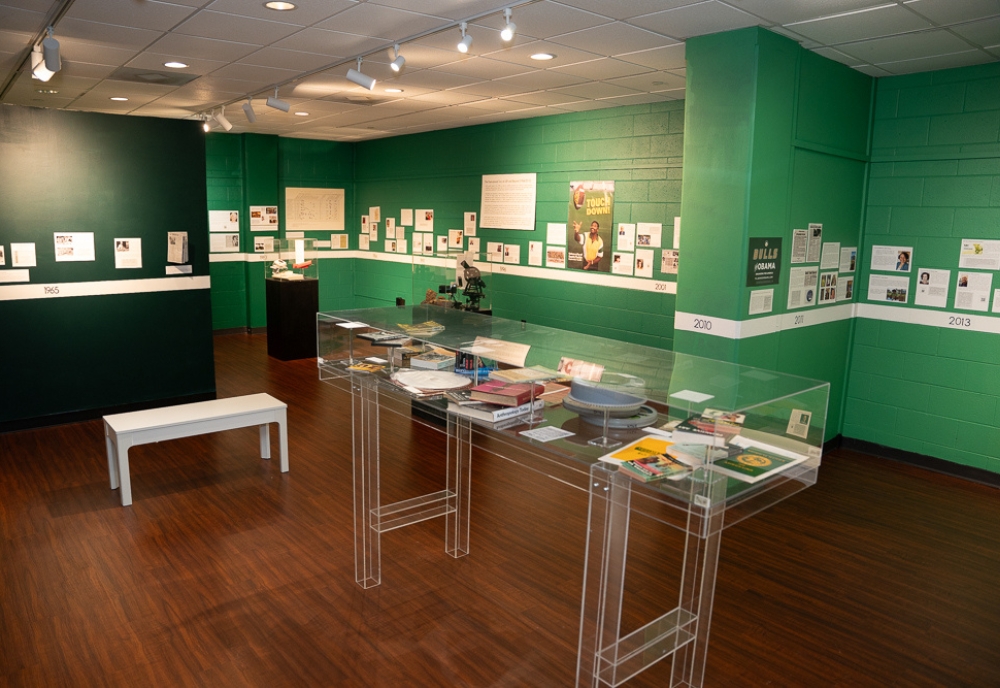The USF College of Arts and Sciences (CAS) Department of Anthropology is celebrating 60 years of teaching students the critical skills needed to conduct effective analyses of “human social phenomena at both the local and global levels.”
With a special emphasis on applied anthropology—the practice of using anthropological knowledge to address real-world issues—the department has provided endless opportunities for its students to not only develop their skills, but apply them through research, internships and service learning, according to Dr. Antoinette Jackson, professor and chair.
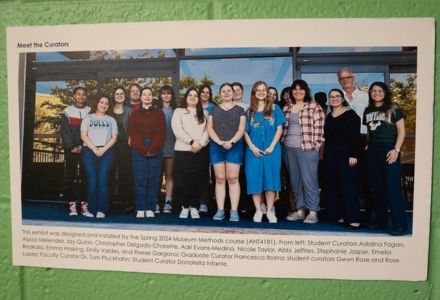
Dr. Thomas Pluckhahn and students in his Museum Methods course included a photo of themselves in the exhibition. (Photo by Corey Lepak)
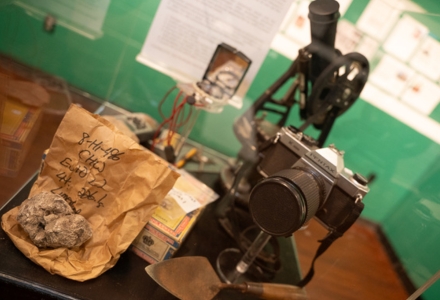
The exhibit includes artifacts in the form of technology used by anthropology faculty over the past 60 years; shown here are a few tools used by archaeologists, including paper bags once used for curation (now replaced by archival quality plastic), a 35 mm SLR camera (now largely replaced by smart phones), and a survey transit (now supplanted by GPS, total stations, and LiDAR, and a trowel (still widely used). (Photo by Corey Lepak)
“We are committed to pursuing research and effecting change that is relevant to communities we serve,” she explained. “We strive to equip students with top-notch research and analysis skills, a critical and holistic way of looking at issues, needs, and concerns, and solving problems. This makes students ready day one after they leave our program to pursue jobs either within or external to the academy.”
She adds that the program prides itself on being the first applied anthropology program in the country, leading the way across the nation in both undergraduate and graduate programs.
“Our work and mission places us at the center of solving real world problems that impact everyday people and places us at the center of collaborations across multiple disciplines and industries to address issues of import on a local and global scale,” she explained.
One such example of these forward-thinking program offerings, and a recent achievement Jackson adds she is particularly proud of, is the creation of a new undergraduate BS major in biomedical anthropology.
“This helps attract students across the university interested in public health, health sciences, and the intersections of medicine and culture through classroom and internship opportunities in medical settings,” she said.
Jackson also adds that students considering earning a degree in anthropology will have the opportunity to gain knowledge from “dynamic and engaging faculty who are pursing exciting research that is important to whatever students are interested in doing. They will get hands-on experiences and get important tools for thinking, seeing, looking, listening, understanding multiple perspectives, and asking questions that will help them make a difference in whatever area of work they decide to pursue.”
One professor providing students this type of hands-on experience is Dr. Thomas Pluckhahn, whose course ‘Museum Methods’ resulted in a full exhibition that is now on display in the Waterman Gallery in the SOC building at the Tampa campus.
He, along with 15 students who took the course last spring, designed, prepared and installed the exhibit they titled “To See Ourselves Like Someone Else: Reflections on 60 Years of Anthropology at USF.”
“I completed an archival search for newspaper stories about our department, but the students did most of the other archival research, mainly using the digital collections of the USF library,” Pluckhahn added.
Students also interviewed current faculty about their memories of the department and visions for its future.
“In addition, we invited retired faculty members to come to class (in person or via Teams) to share their recollections and answer the students’ questions about their experiences—which was sometimes very eye opening for the class,” he added.
To build on the artifacts on display, Pluckhahn said he relied on contributions from his colleagues in the department, digging through his own and other departmental storage closets, and even finding artifacts from eBay.
“The history of the department is largely unwritten, so we had to simultaneously compile the historical facts and interpret them, which is challenging. I wanted this to be a social history, so I encouraged the students to think critically about how events in the history of the department connected with broader social and political currents,” he added. “In addition to all the time that goes into interpretation, there is all the work of fabricating the exhibit: painting the walls, printing the panels, mounting them to foam board, arranging them on the walls, etc. I have taught other classes with coordinated projects, but this was by far the most intensive; it is also the most public facing, which is intimidating—for me and the students.”
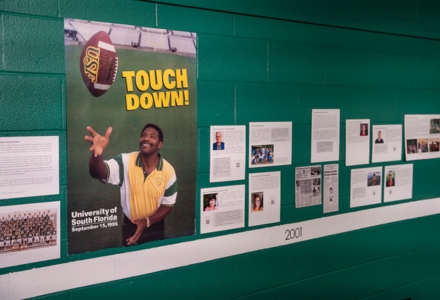
A portion of the timeline covering the late 1990s and early 2000s includes a poster (purchased on eBay) of Lee Roy Selmon commemorating the approval of the football team in 1995; the exhibit notes that Professor Emeritus of Anthropology Dr. Curtis Wiencker was a member of the committee that brought football to campus. (Photo by Corey Lepak)
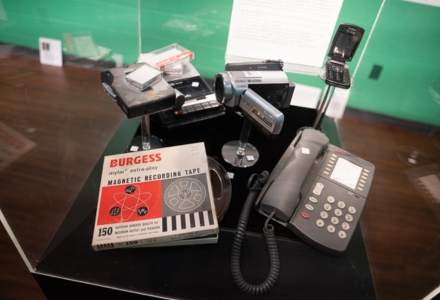
Artifacts used for ethnographic research by anthropology faculty include magnetic reel-to-reel recording tape, portable cassette recorders, handheld video recorders, landline and flip phones, (all now largely replaced by smart phones). (Photo by Corey Lepak)
While challenging, Pluckhahn said the process of completing the exhibition with his students provided a new perspective of the department.
“I came away with a much better understanding of our department and a richer appreciation of our longstanding commitment to applying anthropological research to practice across diverse forms,” he said. “I am proud of seeing the sense of pride and accomplishment that the students felt at the opening of the exhibit—in the company of their parents, friends, peers, and professors.”
The exhibition will be on display through the remainder of the fall semester.
“It feels great to know our program has made such a difference and that we are still going,” Jackson reflected. “There has been so much change over the 60 years and so much change ahead.”
Learn more about degree program offerings available in the Department of Anthropology.
